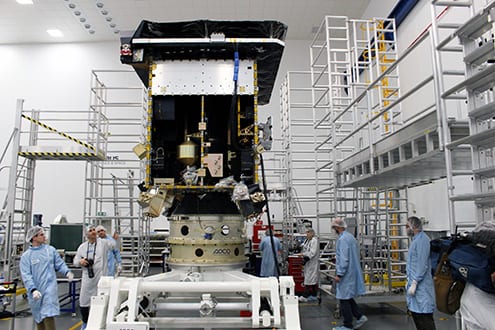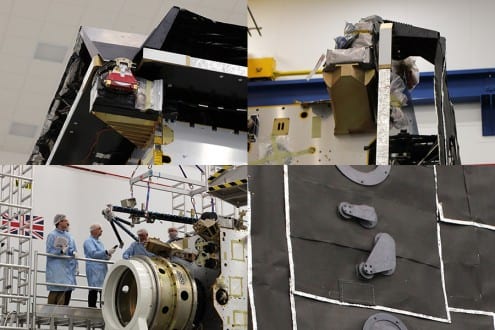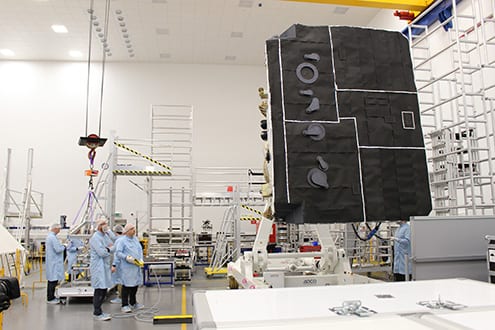Solar Orbiter: here comes the Sun
By Oli Usher, on 25 March 2015
The Solar Orbiter project has moved a step closer to reality, with the completion of its structural thermal model (STM) this month. UCL is heavily involved with this European Space Agency mission, with the university’s Mullard Space Science Laboratory leading the development of parts of its scientific payload.
The spacecraft is being built at Airbus Defence & Space in Stevenage, just north of London.

The Solar Orbiter Structural Thermal Model at Airbus Defence & Space in Stevenage. Photo: O. Usher (UCL MAPS)
The STM is a full-scale model of the spacecraft, which is used for extensive pre-flight testing. Its appearance, structure and design are virtually identical to what will launch in 2018 – the main difference is that the delicate (and costly) electronics are replaced by dummy components that mimic their physical size, weight and properties.
The extensive pre-flight testing, covering potential hazards such as vibration, G-forces and heat resistance (crucial for a solar mission) will be carried out on the STM, to identify potential issues with the flight model before it’s too late.
UCL leads the development of two of the scientific instruments that will fly on board Solar Orbiter.

Louise Harra and Chris Owen, both of UCL Mullard Space Science Laboratory, at the Airbus facility in Stevenage. Photo: O. Usher (UCL MAPS)
The Extreme Ultraviolet Imager, with Louise Harra as a co-PI, will image the atmosphere of the Sun, which is heated by our star’s magnetic field. The solar atmosphere is far hotter than the Sun’s surface – an apparent paradox – and Solar Orbiter will aid scientists in their efforts to shed light on precisely why this is.
The Solar Wind Analyser, led by Chris Owen, will study the particles that make up the solar wind. The solar wind is a constant stream of charged particles churned out by the Sun and blown out into the far reaches of the Solar System. It cannot be studied from the ground, as the particles are deflected by the Earth’s magnetic field.

Dummy models of the scientific instruments UCL is contributing to on the Solar Orbiter STM.
Top left: the Solar Wind Analyser Proton-Alpha Sensor
Top right: the Solar Wind Analyser Heavy Ion Sensor
Bottom left: the Solar Wind Analyser Electron Analyser System (on the boom being attached to the spacecraft)
Bottom right: the apertures in the heat shield behind which the Extreme Ultraviolet Imager is located
One of the unique features of Solar Orbiter, over all other solar observation missions to date, is that it will give an unprecedented perspective on the Sun. During its mission, it will use Venus fly-bys, each time getting a small nudge from the planet. This will gradually move Solar Orbiter out of the plane of the Solar System – where Earth and all the other planets lie – and by about six years into the mission, it will be in a position to look down onto the poles of the Sun. These have never been seen before, and they are crucial to understanding the Sun’s magnetic field.
Solar Orbiter will also fly telescopes closer to the Sun than any spacecraft before and be able to observe features such as sunspots evolve for weeks at a time, thanks to an orbit that follows the rotation of the Sun.
Solar Orbiter will fly inside the orbit of Mercury, at barely over a quarter of the Earth’s distance from the Sun. This means extremely powerful Solar radiation, bright light and intense heat. Part of the engineering challenge of building the spacecraft is its heat shield, which protects Solar Orbiter’s delicate electronics, shielding them from temperatures of 600 degrees and keeping the internal temperature down to a much more manageable 60 degrees.
The instruments can poke through small openings in the heat shield so as to observe the Sun’s surface without being fried.
Solar Orbiter is scheduled for launch in 2018. The launch vehicle will be provided by the United States. Like many space missions, this is a project of international cooperation.
Links
 Close
Close



